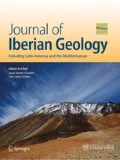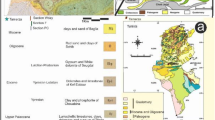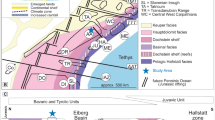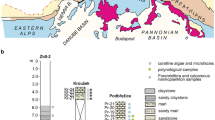Abstract
The sedimentological analysis of the uppermost Kimmeridgian to lower Tithonian Villar del Arzobispo Formation (Galve sub-basin, NE Spain) has allowed characterizing different carbonate, mixed and siliciclastic facies deposited in coastal to shallow marine areas. Its age calibration has been specified on the basis of new biostratigraphic and chemostratigraphic data. Four successive sequences (30–80 m thick) characterized by the relative dominance of carbonate and siliciclastic facies reflect a sedimentary change from reciprocal to mixed carbonate–siliciclastic sedimentation. Sequences 1 and 2 are reciprocal sedimentation cycles from carbonate-dominated (muddy coastal plain-carbonate lagoon) to siliciclastic coasts (muddy coastal plain-wave dominated delta). Sequence S3 is also reciprocal, from a mixed carbonate–siliciclastic coastal plain-lagoon at the lower part to a wave-dominated delta on top. A mixed carbonate–siliciclastic coastal plain-lagoon characterizes the entire sequence 4. Climate and tectonics controlled carbonate deposition and siliciclastic supply. Reciprocal sedimentation in sequences 1–3 was controlled by orbitally-driven climate changes (from arid to humid conditions) on the age range of long-term eccentricity cycles. A greater imprint of extensional synsedimentary tectonics at the upper part of sequence 3 and during sequence 4 is thought to be the main factor producing the gradual opening of the sub-basin to the wave influence and a more continuous siliciclastic supply, then controlling the change from reciprocal to mixed sedimentation and obliterating the possible imprint of orbitally-induced climatic changes.
Resumen
El análisis sedimentológico de la Formación Villar del Arzobispo (sub-cuenca de Galve, NE España), de edad Kimmeridgiense superior a Titoniense inferior ha permitido caracterizar diferentes facies carbonatadas, mixtas y siliciclásticas depositadas en áreas costeras a marinas someras. Su calibración temporal ha sido especificada aportando nuevos datos bioestratigráficos y quimioestratigráficos. Cuatro secuencias sucesivas (de 30 a 80 m de espesor) caracterizadas por el dominio relativo de facies carbonatadas y siliciclásticas reflejan un cambio desde sedimentación recíproca a mixta carbonatada-siliciclástica. Las secuencias 1 y 2 son ciclos de sedimentación recíproca con depósitos carbonatados (llanura costera-laguna carbonatadas) y siliciclásticos (llanura costera a delta dominado por oleaje). La secuencia 3 es también recíproca, registrando una llanura costera-laguna somera mixta carbonatada-siliciclástica en su parte inferior, y un delta dominado por oleaje en la superior. La secuencia 4 está caracterizada por una llanura costera-laguna somera mixta carbonatada-siliciclástica. El clima y la tectónica controlaron la sedimentación carbonatada y los aportes siliciclásticos. Cambios climáticos (condiciones áridas a húmedas) inducidos por factores orbitales controlaron la sedimentación recíproca en las secuencias 1 a 3. La mayor influencia de la actividad tectónica extensiva sinsedimentaria en la parte superior de la secuencia 3 y durante la secuencia 4 se ha propuesto como el factor principal que produjo una apertura gradual de la sub-cuenca a la influencia del oleaje y un aporte siliciclástico más continuo, controlando el cambio de sedimentación recíproca a mixta y obliterando el posible registro de los cambios climáticos orbitales.















Similar content being viewed by others
References
Atrops, F., & Meléndez, G. (1984). Kimmeridgian and Lower Tithonian from the Calanda-Berge area (Iberian Chain, Spain): Some biostratigraphic re-marks. In Proceedings 1st international symposium on jurassic stratigraphy (vol. 2, pp. 377–392). Erlangen.
Aurell, M., Bádenas, B., Gasca, J. M., Canudo, J. I., Liesa, C. L., Soria, A. R., et al. (2016). Stratigraphy and evolution of the Galve sub-basin (Spain) in the middle Tithonian—early Barremian: Implications for the setting and age of some dinosaur fossil sites. Cretaceous Research, 65, 138–162.
Aurell, M., Mas, R., Meléndez, A., & Salas, R. (1994). El tránsito Jurásico–Cretácico en la Cordillera Ibérica: Relación tectónica-sedimentación y evolución paleogeográfica. Cuadernos de Geología Ibérica, 18, 369–396.
Aurell, M., Robles, S., Bádenas, B., Quesada, S., Rosales, I., Meléndez, G., et al. (2003). Transgressive–regressive cycles and Jurassic palaeogeography of northeast Iberia. Sedimentary Geology, 162, 239–271.
Aurell, M., Val, J., Bádenas, B., & Liesa, C. (2019). Discordancias asociadas a una etapa de rift del final del Jurásico en el sector central de la Subcuenca de Galve (Aguilar del Alfambra, Teruel). Geogaceta 65 (in press).
Bádenas, B., Aurell, M., & Gasca, J. M. (2018). Facies model of a mixed clastic–carbonate, wave-dominated open-coast tidal flat (Tithonian–Berriasian, north–east Spain). Sedimentology, 65(5), 1631–1666.
Bádenas, B., Salas, R., & Aurell, M. (2004). Three orders of regional sea-level changes control facies and stacking patterns of shallow platform carbonates in the Maestrat Basin (Tithonian–Berriasian, NE Spain). International Journal of Earth Sciences, 93(1), 144–162.
Bassoullet, J. P. (1997). Les grands foraminifères. Bulletin du Centre de Recherches Elf Exploration Production Mémoires, 17, 293–304.
Bellotti, P., Milli, S., Tortora, P., & Valeri, P. (1995). Physical stratigraphy and sedimentology of the Late Pleistocene–Holocene Tiber Delta depositional sequence. Sedimentology, 42(4), 617–634.
Bhattacharya, J. P., & Giosan, L. (2003). Wave-influenced deltas: Geomorphological implications for facies reconstruction. Sedimentology, 50(1), 187–210.
Bhattacharya, J. P., & Walker, R. G. (1992). Deltas. In R. G. Walker & N. P. James (Eds.), Facies models: Response to sea-level change (pp. 157–177). St Johns: Geological Association of Canada.
Bover-Arnal, T., Moreno-Bedmar, J. A., Frijia, G., Pascual-Cebrian, E., & Salas, R. (2016). Chronostratigraphy of the Barremian-Early Albian of the Maestrat Basin (E Iberian Peninsula): Integrating strontium-isotope stratigraphy and ammonoid biostratigraphy. Newsletters on Stratigraphy, 49(1), 41–68.
Bryant, J. D., Jones, D. S., & Mueller, P. A. (1995). Influence of freshwater flux on 87Sr/86Sr chronostratigraphy in marginal marine environments and dating of vertebrate and invertebrate faunas. Journal of Paleontology, 69, 1–6.
Campos-Soto, S., Cobos, A., Caus, E., Benito, M. I., Fernández-Labrador, L., Suarez-Gonzalez, P., et al. (2017). Jurassic Coastal Park: A great diversity of palaeoenvironments for the dinosaurs of the Villar del Arzobispo Formation (Teruel, eastern Spain). Palaeogeography Palaeoclimatology Palaeoecology, 485, 154–177.
Canicio, A., & Ibanez, C. (1999). The Holocene evolution of the Ebro Delta, Catalonia, Spain. Acta Geographica Sinica, 54, 462–469.
Canudo, J. I., Aurell, M., Barco, J. L., Cuenca-Bescós, G., & Ruiz-Omeñaca, J. I. (2005). Los dinosaurios de la Formación Villar del Arzobispo (Titónico medio-Berriasiense inferior) en Galve (Teruel). Geogaceta, 38, 39–42.
Canudo, J. I., Gasca, J. M., Moreno-Azanza, M., & Aurell, M. (2012). New information about the stratigraphic position and age of the sauropod Aragosaurus ischiaticus from the Early Cretaceous of the Iberian Peninsula. Geological Magazine, 149(2), 252–263.
Castanera, D., Barco, J. L., Díaz-Martínez, I., Gascón, J. H., Pérez-Lorente, F., & Canudo, J. I. (2011). New evidence of a herd of titanosauriform sauropods from the lower Berriasian of the Iberian range (Spain). Palaeogeography Palaeoclimatology Palaeoecology, 310, 227–237.
Catuneanu, O., Galloway, W. E., Kendall, C. G. S. C., Miall, A. D., Posamentier, H. W., Strasser, A., et al. (2011). Sequence stratigraphy: Methodology and nomenclature. Newsletters on Stratigraphy, 44(3), 173–245.
Cobos, A., Royo-Torres, R., Luque, L., Alcalá, L., & Mampel, L. (2010). An Iberian stegosaurs paradise: The Villar del Arzobispo Formation (Tithonian–Berriasian) in Teruel (Spain). Palaeogeography Palaeoclimatology Palaeoecology, 293(1–2), 223–236.
Coleman, J. M., & Wright, L. D. (1975). Modern river deltas: Variability of processes and sand bodies. In: Deltas: Models for Exploration, AAPG, pp 99–149.
Cuenca-Bescós, G., Badiola, A., Canudo, J. I., Gasca, J. M., & Moreno-Azanza, M. (2011). New Dryolestidan Mammal from the Hauterivian—Barremian Transition of the Iberian Peninsula. Acta Palaeontologica Polonica, 56(2), 257–267.
Dahanayake, K. (1977). Classification of oncoids from the Upper Jurassic carbonates of the French Jura. Sedimentary Geology, 18(4), 337–353.
Davies, P., Symonds, P., Feary, D., & Pigram, C. (1989). The evolution of the carbonate platforms of northeast Australia. In P. Crevello, J. Wilson, J. Sarg, & J. Read (Eds.), Carbonate platform and basin development (Vol. 44, pp. 233–257). Tulsa: SEPM (Society for Sedimentary Geology) Special Publication.
Davis, R. A. (1978). Beach and nearshore zone. Coastal sedimentary environments (pp. 237–285). New York: Springer.
Díaz-Molina, M., & Yébenes, A. (1987). La sedimentación litoral y continental durante el Cretácico Inferior. Sinclinal de Galve, Teruel. Estudios Geológicos, 43, 3–21.
Díaz-Molina, M., Yébenes, A., Goy, A., & Sanz, J. L. (1984). Landscapes inhabited by Upper Jurassic/Lower Cretaceous archosaurs. In III Symposium Mesozoic terrestrial ecosystems (pp. 67–72).
Doyle, L. J., & Roberts, H. H. (1988). Carbonate—clastic transitions, developments in sedimentology (Vol. 42, p. 304). Amsterdam: Elsevier.
Fanos, A. M., Khafagy, A. A., & Komar, P. D. (1995). Long and short term changes of Rosetta Promontory, Egypt. In E. Ozhan (Ed.), MEDCOAST 95 (pp. 1033–1046). Ankara: MEDCOAST.
Flügel, E. (2010). Microfacies and archaeology. Microfacies of carbonate rocks (pp. 903–915). Berlin: Springer.
Föllmi, K. (2012). Early Cretaceous life, climate and anoxia. Cretaceous Research, 35, 230–257.
García-Penas, A., & Aurell, M. (2017). Tectono–sedimentary evolution around the Jurassic–Cretaceous transition in Galve (Aguilar del Alfambra Formation, Teruel, Iberian Chain). Revista de la Sociedad Geológica de España, 30(2), 79–90.
Geyer, O. F., & Pelleduhn, R. (1979). Sobre la estratigrafía y la facies espongiolítica del Kimmeridgiense de Calanda (provincia de Teruel). Cuad. Geol, 10, 67–72.
Goldhammer, R. (2003). Cyclic sedimentation. In G. Middleton, M. Church, M. Coniglio, L. Hardie, & F. Longstaffe (Eds.), Encyclopedia of sediments and sedimentary rocks (pp. 271–293). The Netherlands: Springer.
Gradstein, F. M., Ogg, J. G., Schmitz, M., & Ogg, G. (2012). The geologic time scale 2012. Oxford: Elsevier.
Hay, W., & Floegel, S. (2012). New thoughts about the Cretaceous climate and oceans. Earth Science Reviews, 115, 262–272.
Hernández, A., Godoy, A., Alvaro, M., Ramírez, J., Leal, M., Aguilar, M., et al. (1985). Mapa Geológico de España. Escala 1:200.000 (First edition), nº47 (Teruel). Madrid: IGME.
Hower, J. (1961). Some factors concerning the nature and origin of glauconite. American Mineralogist Journal of Earth and Planetary Materials, 46, 313–334.
Hunter, R. E. (1977). Basic types of stratification in small eolian dunes. Sedimentology, 24(3), 361–387.
Ineson, J., & Surlyk, F. (2000). Carbonate mega-breccias in a sequence stratigraphic context: Evidence from the Cambrian of North Greenland. In D. Hunt & R. Gawthorpe (Eds.), Sedimentary responses to forced regression (Vol. 172, pp. 47–68). London: Geological Society of London Special Publications.
Liesa, C. L., Soria, A. R., Casas, A., Aurell, M., Meléndez, N., Bádenas, B., et al. (2018). The Late Jurassic–Early Cretaceous rifting stage at the central and eastern Iberian Basin: The central and eastern Iberian Basin. Geology of Iberia: A geodynamic approach. Berlin: Springer.
Liesa, C. L., Soria, A. R., Meléndez, N., & Meléndez, A. (2006). Extensional fault control on the sedimentation patterns in a continental rift basin: El Castellar Formation, Galve sub-basin, Spain. Journal of the Geological Society, 163(3), 487–498.
Maldonado, A. (1975). Sedimentation, stratigraphy, and development of the Ebro Delta, Spain. In M. L. Broussard (Ed.), Deltas, models for exploration (pp. 311–338). Houston: Houston Geological Society.
Mas, R., Alonso, A., & Meléndez, N. (1984). La formación Villar del Arzobispo: Un ejemplo de llanuras de marea siliciclásticas asociadas a plataformas carbonatadas. Jurásico terminal (NW de Valencia y E de Cuenca). Publicaciones de Geología, 20, 175–188.
McArthur, J. M., Howarth, R. J., & Shields, G. A. (2012). Strontium isotope stratigraphy. In: The geologic time scale (pp. 127–144).
Meléndez, N., Liesa, C. L., Soria, A. R., & Meléndez, A. (2009). Lacustrine system evolution during early rifting: El Castellar formation (Galve sub-basin, Central Iberian Chain). Sedimentary Geology, 222(1–2), 64–77.
Meléndez, A., Pardo, G., Pendón, J. G., & Villena, J. (1979). Las facies terminales del Jurásico en el sector central de la Cordillera Ibérica. Cuad. Geol., 10, 137–148.
Mount, J. (1984). Mixing of siliciclastic and carbonate sediments in shallow shelf environments. Geology, 12, 432–435.
Niedoroda, A. W., Swift, D. J., Hopkins, T. S., & Ma, C. M. (1984). Shoreface morphodynamics on wave-dominated coasts. Marine Geology, 60(1–4), 331–354.
Park, R. K. (2010). The impact of sea-level change on ramp margin deposition: Lessons from the Holocene sabkhas of Abu Dhabi, United Arab Emirates. Quaternary Carbonate and Evaporite Sedimentary Facies and Their Ancient Analogues A Tribute to Douglas James Shearman, 24, 89–111.
Pérez-Lorente, F., & Ortega, F. (2003). Dos nuevos rastros de arcosaurios en el Cretácico inferior de Galve (Teruel. España). Dinosaurios y otros reptiles mesozoicos en España (pp. 129–136). La Rioja: Instituto de Estudios Riojanos.
Purdy, E. G., & Gischler, E. (2003). The Belize margin revisited: 1. Holocene marine facies. International Journal of Earth Sciences, 92(4), 532–551.
Ruiz-Omeñaca, J. I., Canudo, J. I., Aurell, M., Bádenas, B., Barco, J. L., Cuenca-Bescós, G., et al. (2004). Estado de las investigaciones sobre los vertebrados del Jurásico Superior y Cretácico Inferior de Galve (Teruel). Estudios Geológicos, 60(3–6), 179–202.
Salas, R., Guimerà, J., Mas, R., Martín-Closas, C., Meléndez, A., & Alonso, A. (2001). Evolution of the Mesozoic central Iberian Rift System and its Cainozoic inversion (Iberian chain). Peri Tethys Memoir, 6, 145–185.
Saller, A., Dickson, J., Rasbury, E., & Ebato, T. (1999). Effects of long-term accommodation change on short-term cycles, Upper Palaeozoic platform limestones, West Texas. In P. Harris, A. Saller, & J. Simo (Eds.), Advances in sequence stratigraphy: Application to reservoirs outcrops and models (Vol. 63, pp. 227–246). Tulsa: SEPM (Society for Sedimentary Geology) Special Publication.
Schwarz, E., Veiga, G. D., Trentini, G. Á., & Spalletti, L. A. (2016). Climatically versus eustatically controlled, sediment-supply-driven cycles: Carbonate–siliciclastic, high-frequency sequences in the Valanginian of the Neuquén Basin (Argentina). Journal of Sedimentary Research, 86(4), 312–335.
Sestini, G. (1989). Nile delta: A review of depositional environments and geological history. In M. K. G. Whateley & K. T. Pickering (Eds.), Deltas: Sites and traps for fossil fuel (Vol. 41, pp. 99–127). London: Geological Society London Special Publications.
Southgate, P. N., Kennard, J. M., Jackson, M. J., O’Brien, P. E., & Sexton, M. J. (1993). reciprocal lowstand clastic and highstand carbonate sedimentation, subsurface Devonian Reef Complex, Canning Basin, Western Australia. In R. Locks & J. Sarg (Eds.), Carbonate sequence stratigraphy (Vol. 57, pp. 157–179). New York: AAPG Memoir.
Strasser, A. (1986). Ooids in Purbeck limestones (lowermost Cretaceous) of the Swiss and French Jura. Sedimentology, 33(5), 711–727.
Taylor, A. M., & Goldring, R. (1993). Description and analysis of bioturbation and ichnofabric. Journal of the Geological Society of London, 150, 141–148.
Tucker, M. E. (2003). Mixed clastic–carbonate cycles and sequences: Quaternary of Egypt and Carboniferous of England. Geologia Croatica, 56(1), 19–37.
Vaidyanadhan, R., & Rao, M. S. (1979). Morphology and evolution of Godavari delta, India. Zeitschrift für Geomorphologie, 23, 243–255.
Van Houten, F. B., & Purucker, M. E. (1984). Glauconitic peloids and chamositic ooids-favorable factors, constraints, and problems. Earth Science Reviews, 20(3), 211–243.
Van Siclen, D. C. (1958). Depositional topography—examples and theory. AAPG Bulletin, 42(8), 1897–1913.
Vennin, E., & Aurell, M. (2001). Stratigraphie sequentielle de l’Aptien du sous-bassin de Galve (Province de Teruel, NE de l’Espagne). Bulletin de la Société Géologique de France, 172(4), 397–410.
Walker, R. G. (1984). Facies models: Geoscience Canada, reprint series 1 (p. 317). Alberta: Geological Association of Canada.
Wierzbowski, H., Anczkiewicz, R., Pawlak, J., Rogov, M. A., & Kuznetsov, A. B. (2017). Revised Middle-Upper Jurassic strontium isotope stratigraphy. Chemical Geology, 466, 239–255.
Wilson, J. L. (1967). Cyclic and reciprocal sedimentation in Virgilian strata of southern New Mexico. Geological Society of America Bulletin, 78(7), 805–818.
Acknowledgements
This work has been supported by the project CGL2017-85038-P subsidized by the Spanish Ministry of Science and Innovation, the European Regional Development Fund and the project H54 of the Government of Aragón (‘Grupos Consolidados’ and ‘Dirección General de Patrimonio Cultural’). Diego Castanera is supported by AGAUR, (Beatriu de Pinós Programme, BP2017). The authors are sincerely thankful to Telm Bover Arnal and another anonymous reviewer, whose useful suggestions have improved the quality of this paper.
Author information
Authors and Affiliations
Corresponding author
Rights and permissions
About this article
Cite this article
Val, J., Aurell, M., Bádenas, B. et al. Cyclic carbonate–siliciclastic sedimentation in a shallow marine to coastal environment (latest Kimmeridgian–early Tithonian, Galve sub-basin, Spain). J Iber Geol 45, 195–222 (2019). https://doi.org/10.1007/s41513-018-00098-1
Received:
Accepted:
Published:
Issue Date:
DOI: https://doi.org/10.1007/s41513-018-00098-1
Keywords
- Carbonate–siliciclastic
- Coastal transition
- Sequences
- Synsedimentary tectonics
- Upper Jurassic
- Galve sub-basin





